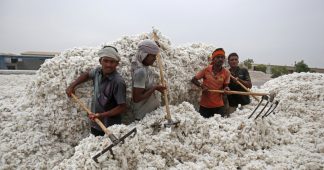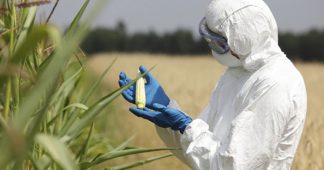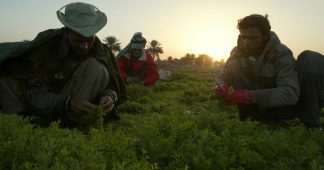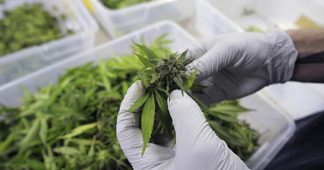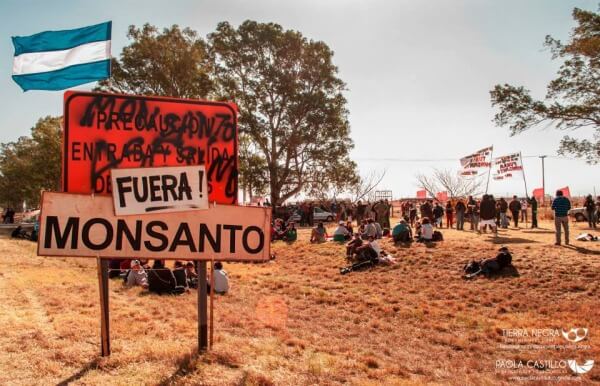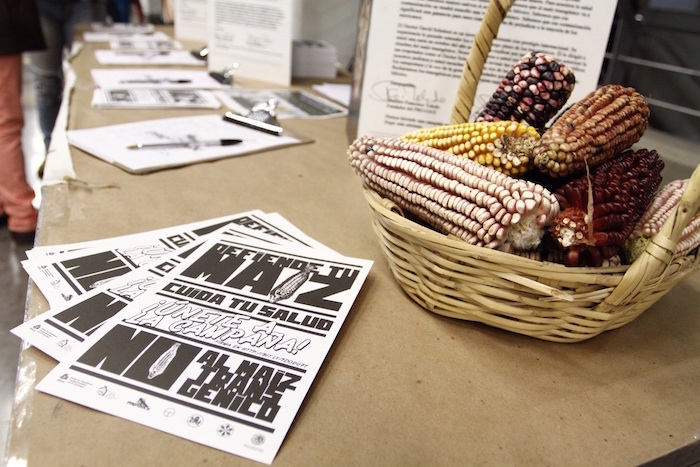Our food security hinges on the struggle now underway over who controls the earth’s seeds
By Mark Schapiro
September 16, 2018
Ten thousand years after humans became less nomadic and learned how to cultivate crops, veteran investigative journalist Mark Schapiro plunges into the struggle already underway for control of seeds, the ground-zero ingredient for our food. Three-quarters of the seed varieties on Earth in 1900 had become extinct by 2015. In “Seeds of Resistance,” Schapiro takes us to the front lines of a struggle over the seeds that remain — a struggle that will determine the long-term security of our food supply in the face of unprecedented climate volatility.
* * *
A Seed Chronicle Foretold
A seed story, like life, starts small and gets bigger.
In the mid-1990s, a letter arrived at a simple adobe-style office on a dusty lot on the outskirts of Tucson, Arizona. The site, headquarters of Native Seeds/SEARCH, an organization which saves seeds native to the southwest, is little more than a couple of garden plots and a refrigerator and freezer filled with indigenous seeds. Here you can find seeds that have inherited characteristics dating back as far as three-thousand years.
The letter came from a lawyer for the food company Frito Lay, known for its processed snack foods. It warned that one of Native Seeds/SEARCH’s best-selling products, Indian Parched Corn, was in violation of the Frito Lay trademark. Parched corn are chunky salted corn kernels that have been prepared for centuries by Hopi, Apache, and other tribes in Arizona and New Mexico. (A reminder to the non-botanical: kernels are in fact seeds, so when you eat corn you’re eating a corn seed.) The company lawyer demanded that Native Seeds/SEARCH immediately “cease and desist” using language equating the native corn with two words that had been trademarked by the company—Corn Nuts™.
The command arrived like a tragicomic bolt from the big-food universe. A multi-billion-dollar company was objecting to language used by a tiny seed saving enterprise promoting a seed that has been around for hundreds, if not thousands, of years, long before Frito Lay was a phantasm in the mind of the first mass marketer of the potato chip, Herman Lay, in 1932. The parched corn comes in four and eight-ounce bags with yellow, blue, and red kernels, reflecting the diversity of some eight hundred different corn varieties, cultivated from the American southwest down to southern Mexico. It’s not as if the inhabitants of this region had to go to Frito Lay to figure out how to make the tasty morsels made from dried corn kernels. They’ve been doing it for centuries, through an age-old practice of boiling (“parching”) the kernels, drying them and adding salt.
The main supplier to Native Seeds/SEARCH is the Santa Ana Pueblo in neighboring New Mexico, located about twenty-five miles from Albuquerque, home to a federally recognized tribe which dates its presence in the area to at least the sixteenth century. Talavai Denipah-Cook, a twenty-three-year-old Hopi woman who works as an ecologist on tribal lands and grew up in the Ohkay Owingeh Pueblo, just north of Santa Fe, recalled to me in 2017 that she used to enjoy eating parched corn regularly as a kid. “They’re crunchy and delicious,” she said. They taste, well, like nuts made from corn.
No matter how well disguised the decorative packaging or how thoroughly they’ve been put through the additive grinder, the genes of the corn used by Frito Lay emanate from seeds that are relatives of the seeds that have been cultivated by indigenous Americans (North and South) for thousands of years. Generation upon generation of the region’s farmers ensured that the seeds’ genetic pool was preserved, and thus provided the foundational raw material for the company’s processed food concoctions.
The seed group could have responded by requesting that Frito Lay, itself a subsidiary of gigantic PepsiCo, express its gratitude for the centuries of corn cultivation by the peoples of what is now Mexico and the American Southwest.
That didn’t happen.
Without the resources to fight one of the world’s biggest food companies, Native Seeds/SEARCH changed the disputed wording. “Parched Corn” packets now state, simply and directly, “Parched without oil for a healthy, crunchy, and uniquely Southwestern snack.”
“They seemed to come from a different continent, a different world,” said Laura Jones, the group’s acting director, as she recalled the incident in 2016, while ushering me into the group’s refrigerated seed vault one hot summer morning in Tucson. She opened a foot-thick steel door, and we walked into the refreshingly cold air. There, on steel shelves, I gazed upon the genetic history of the American southwest. Piled into plastic canisters were seeds of every description—small ragged-edged oblong seeds, square-ish, round and trapezoidal seeds, future beans, squash, peas, corn, a desert wheat, and many others in dark browns, light browns, blues, blacks, yellows and whites. “This is our palette of genetic diversity, our insurance that we’ll be able to survive and thrive here in the southwest,” Jones said. As the world comes to resemble Arizona—hot and dry—those seeds are becoming ever more invaluable.
Though a legal conflict was averted, the larger question at the heart of this dispute remains: who controls our seeds? We members of the public have a major stake in the answers to that question, which will determine the quality, nutrition, and healthfulness of the food that we eat, especially as our planet’s ecosystems are being degraded and unsettled.
The financial wizard played by Brad Pitt in the film The Big Short advises his young acolytes that “seeds are . . . the new currency.” Indeed, while few were looking, seeds became one of the hottest properties in the corporate market. American and European seed companies have been buccaneering their way through the world’s seeds, picking and choosing the ones to patent and put into mass production. This means they have retained exclusive rights to resources that have been in the public domain for millennia.
By 2018, after a frenzy of mergers and acquisitions, just three companies controlled more than half of all seed revenues, and a growing percentage of the living germplasm embedded in those seeds. The primary business for all three, now fused into globe-stretching merged companies—DowDuPont, Bayer-Monsanto, and Syngenta-ChemChina—is not seeds, but agricultural chemicals. The combination of chemical and seed companies is giving rise to seeds that are born addicted to chemicals for their survival—entire generations full of crack-baby seeds.
One major result has been the accelerating disappearance of seed diversity at just the time when we require a broader genetic spectrum to adapt to the volatile impacts of our changing climate. Changes in growing conditions are convulsing the planet’s food-growing lands. The changes are coming more quickly, and less predictably, than our ability to breed seeds can respond. The time by which adaptability to new conditions must occur is shortening. We can no longer wait the average five-to-ten- or even fifteen-year time span needed to breed a new variety.
Not only is it getting hotter and drier, tumult in the atmosphere is delivering conditions that we can no longer predict, which means that agriculture has to respond both to the current set of conditions, and to new and more volatile conditions, which may be just a season or two ahead. Climate change is heightening the stakes in our search for seeds that can adapt to an accelerating pace of unknowns. “There’s no precedent at all for what we’re going to see,” George Frisvold, a professor of Agricultural and Resource Economics at the University of Arizona, told me, when I visited him in his office on the other side of town from Native Seeds/SEARCH in Tucson. Frisvold served on President Clinton’s Council of Economic Advisers where, in the 1990s, he began trying to gauge the impact of climate change on our food system. Now, it seems, the concerns they had at the time are coming true like a chronicle foretold. “We don’t really know how bad it’s going to get.”
A diversity of seeds is imperative to enable us to withstand this period of accelerating environmental stress. Threats loom. The conflict over Corn Nuts in many ways reflects the larger conflict over control of the seeds and thus our ability to respond to climate chaos as the world’s most important public resource falls increasingly into private hands.
Security of our food supply is the big story, and its filled with many smaller stories along the way. Here’s another one.
May 19, 2017 was the day that the inconceivable happened. In the far north of Norway during a record-breaking warm spring day, preceded by a record-breaking warm fall, rain fell instead of snow. The permafrost melted and sent water fifty feet into the entryway of a three-hundred-foot long mountain tunnel leading to the world’s largest repository of seeds: the Svalbard Global Seed Vault. Close to a million seed samples are stored inside, representing the germplasm of more than four thousand distinct food crops, a seed cornucopia—including beans from the American Southwest, corn from Mexico, rice from Southeast Asia, potatoes from Peru, wheat from the Middle East, cowpeas from the horn of Africa, and pomegranates from Central Asia. The vault had been deemed impregnable, the safest imaginable place for hedging against the disappearance of genetic resources that are the source-pool for our present and future food. Suddenly the world’s “failsafe” backup seemed exceedingly vulnerable.
The earth’s most important genetic resources, protected by an entire mountain, were threatened by the direct impact of the earth’s most significant man-made threat: climate change. It would be hard to find a more apt and ominous foreshadowing for the challenges ahead for the world’s seeds.
The flood at Svalbard was a brutal reminder of the difference between a diversity of seeds in a frozen vault—whether in Norway or Tucson or any of the dozens of such facilities across the world—and a diversity of seeds out growing in the fields, responding and adapting to conditions that are changing more dramatically and decisively than ever before. The seed vault at Svalbard offers some reassurance that the resource key to human survival has an important, if imperfect, backstop to disappearing forever. But its inadequacy was also revealed. The tundra melted and with it the false sense of security we might have enjoyed in thinking about a vault inside a mountain—or a vault anywhere for that matter. There have been numerous studies documenting the ideal temperature at which seeds can be kept alive. Keeping seeds alive in a jar or a Petri dish, though, is far different from keeping seeds alive when they are growing in a field, exposed to and interacting with the elements.
The Svalbard seeds were ultimately saved when an emergency Norwegian team was able to block the water in the entrance corridor before it reached them deeper inside the vault. The world breathed a sigh of relief. But outside the vault, in the fields of the earth, seeds face far greater threats than they do from a melting mountain, and these threats are not on the horizon. They are here, now. The converging forces of economic concentration and ecological disruption have far greater implications for the future of our food security than the ice-mountain meltdown at Svalbard.
I visited a seed vault for the first time in 1982, as a young journalist. There was a crisis in American farm country: farmers were being squeezed by a narrowing of dominant players in the global commodity markets and government policies favoring large farms. Family farmers were disappearing at nearly unprecedented rates, displaced from the land that many had farmed for generations. This was the first big shift in American agriculture. Family farms were being combined and consolidated into large commodity-oriented farms. (Within thirty years, by 2015, more than half of all Iowan farmland was owned by absentee landlords).
Genetic resources, it was said, were going with them. I’d never heard of genetic resources, but they sounded important. They certainly didn’t seem like anything you could see, visit, or hold onto.
I finagled a magazine assignment—‘new phenomenon, seed banks!’—and hopped an Amtrak train from Oakland, California across the sprawling flat Great Basin of Nevada and Utah, and into the Rocky Mountains. The National Seed Storage Laboratory in Fort Collins, Colorado was the first refrigerated seed storage facility in the United States. Located on the campus of Colorado State University and run by the US Department of Agriculture (USDA), it’s where I learned what a genetic resource is: a seed.
Seeds contain genes accumulated over many seasons. From the most succulent fruit to the most bitter vegetable, every seed contains codes, braided into their DNA, that signal countless factors, including how much of each of those elements is needed to transform the seed into a plant, and if we’re lucky, an edible, nutritious, and tasty one.
We see the ones that survive because of their particular combinations and ability to adapt. Those that can’t survive are lost, often forever. Those that do survive have particular genetic combinations enabling them to change with the circumstances. At first domesticated agriculture was very much hit-or-miss, a mix of blind faith and pleas to the gods. But over time, the differing response of crops to water, sunshine, and soil started to make sense to the people who planted them. Patterns became clear. Every season became the test of a hypothesis. Maybe this or that seed will do better in the heat, or with diminished water, or fighting off a new threat. Harvests would prove or disprove the thesis.
Season after season this was the science—though it wasn’t called that—which lays behind growing our own food. Which is why seeds are called “genetic resources”—they have the genes to survive and thrive, characteristics which, through intentional or accidental combinations, pass those characteristics onward. They are a resource borne from the fundamental Darwinian forces of ecological balance and brutal selection.
Humans, of course, have stored seeds for millennia, in barrels and urns, barns and basements, but the Fort Collins seed bank was the first outfit to create a “safe space” for seeds, intended not necessarily for planting but for preservation, to protect them from the threats outside. Two decades later, the director of the NSSL (since renamed the National Center for Genetic Resources Preservation), was among a group of distinguished scientists working with the Crop Diversity Trust to establish the Svalbard Seed Vault.
Inside a nondescript concrete block were thousands of seeds from every major food crop grown in North America. I recall the space as utilitarian—little more than row upon row of multi-colored and differently shaped seeds in jars and plastic pouches perched on steel shelves behind a walk-in freezer door—very much like those I would see decades later, on a smaller scale, in Tucson. The vibe was slightly medical and spooky sci-fi. I recall a sense of fascination with the place, but no sense of urgency; it seemed like a zoo for living seeds rather than a last-stand redoubt for a precious resource. For those running the institution, though, the intent was clear: to insure the primary ingredient of our food supply against future human and natural threats.
Looking back, it seems like an age of innocence. Back then, the primary threats to seed diversity were rapidly expanding cities, the slowly encroaching impacts of desertification, and the shift to cultivating commodity crops on ever-larger farms, which was leading to increased reliance on monocultures. Who could guess that within a decade dozens of formerly independent seed companies would be purchased by the world’s largest chemical companies? Or that those companies would eliminate thousands of locally evolved seeds and favor the ones reliant on their chemicals? Or that genes from an unrelated organism would be inserted into germplasm to create genetically modified crops that would displace competing seeds? Or, critically, that all this would occur as the accumulation of greenhouse gases—barely a glimmer on most scientist’s radar at the time—would threaten the status quo growing conditions on the earth’s food-growing lands?
Farmers live with the consequences of these changing conditions every day. Each of the three essential elements that triggers a seed to become a plant—sun, water, and soil—are being altered profoundly by climate change. What we non-farmers might experience as another overly warm day, or perhaps even a welcome freak rainstorm, can for a farmer mean the difference between the life or death of their crops.
Despite the absurd and tragic denial of the facts by US President Donald Trump, one thing is clear: it’s not getting any cooler. Rain is not falling when it used to, and when it does, it comes in increasingly intense and destructive bursts. The United Nation’s International Panel on Climate Change, the leading international body of climate scientists, says that our current emissions scenario will lead to a three-to five-degree Fahrenheit global temperature increase by 2050. At current emission trajectories, US farm productivity will likely decline by 2.8 percent to 4. percent annually and drop to pre-1980 levels by 2050, according to a team of scientists centered at the University of Maryland in a study published by the National Academy of Sciences.
One-sixth of all agricultural production is traded internationally, which means, as the USDA concluded, water and heat stresses are likely to have a severe impact on the “types and costs of food available for import.” We’re already seeing the impacts: yields of tree crops are falling in California’s Central Valley because it does not get cold enough to permit a metabolic slow-down in the winter before trees blossom with fruit in the spring. Millions of acres are being fallowed each year in California, in the Southwestern states of Arizona, New Mexico, and Texas, and in the Midwestern wheat belt of Kansas and Nebraska, because there is not enough water to sustain crops. Fifty-six percent of the world’s irrigated crops and 21 percent of rain-fed crops—a total of one-third of all food production—are already in areas subject to severe water stress, according to Ceres, a non-governmental organization (NGO) of financial professionals working with companies to address environmental risk.
Heads up: here comes the desert to a neighborhood near you or a neighborhood where your food is grown. Every year another thirty million acres of food-growing lands are lost to desertification, says the United Nation’s Food and Agriculture Organization. Many of those in the direct path of desertification are in key food growing areas of the planet—including South Africa, Australia, Jordan, Peru, southwest China and, much closer to home for North Americans, southern California, much of Texas, large parts of Arizona and, south of the border, major farming regions of Mexico and Central America. As if that’s not enough, ag journals like Global Change Biology, Plant Disease, and the Journal of Insect Conservation are full of reports of new plant and livestock pests and diseases following the rising heat northward. The biggest challenge for the United States and for the world is how to continue producing food in these turbulent conditions.
The USDA’s alarm over the disruptive impacts of climate change on agriculture mounted during the latter years of the Obama administration—culminating with a report on the “profound threat” to food supply chains from climate-disruptions in the United States, and in the country’s most important sources of food imports.
“The geography of agriculture is changing,” Margaret Walsh, chief author of the report, told me. About a year after I spoke with her, after Donald Trump assumed the presidency, the USDA issued a directive ordering its employees to remove the words “climate change” from the agency’s vocabulary.10 Alas, that semantic trick will do nothing to change the underlying reality.
Our food security hinges on the struggle now underway over who controls the earth’s seeds as the ground shifts beneath our feet.
# # #
Mark Schapiro’s book, “Seeds of Resistance: The Fight to Save Our Food Supply,” comes out on September 18, 2018 from publisher Hot Books.
Published at https://www.salon.com/2018/09/16/seed-diversity-is-disappearing-and-3-chemical-companies-own-more-than-half/
